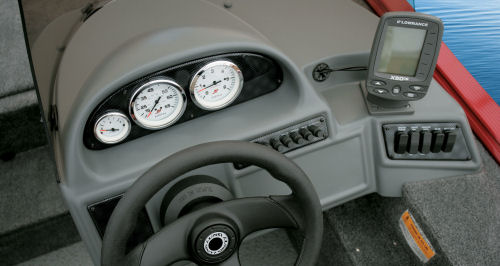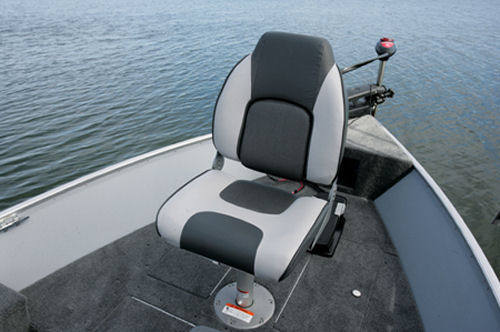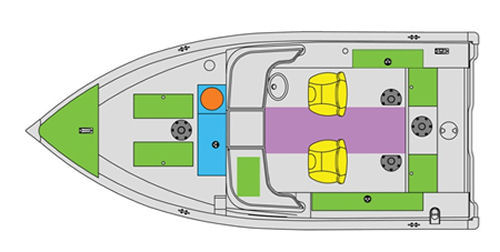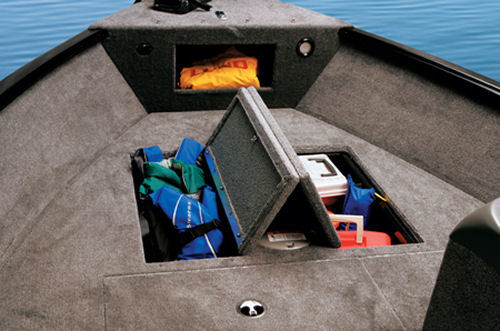Lund 1625 Rebel - A Fishing Boat for a Couple
There are three versions of the Rebel 1625 XL: Tiller, SS and Sport. The Tiller version steers, as its name implies, with a tiller, using Mercury’s hydraulic assist. It’s fine for rivers or sheltered waters, and has the most fishing space of any of the three. Many anglers would rather have a wheel, which the SS version seen above. The Sport model has two consoles. Both the SS and Sport have more standard equipment, and can handle a larger motor, 75 hp vs. 60 for the Tiller.
 Lund’s 1625 Rebel XL is the perfect boat for the fishing couple. The company builds three variations of the aluminum 16-footer – this one is the SS -- so you can have it your way. Or, more likely, your wife’s way, if she likes to fish. At least if she’s fishing, she won’t be wasting your time and money fixing up the house. |
They say if you give a man a fish, you feed him for a day, but teach him to fish and you feed him for a lifetime. How touching … but we have a different version: Give a woman a fish, and she’ll make you clean it; teach her to fish, and maybe she’ll let you buy a new boat. Sounds like a deal to us.
 The Rebel 1625 XL Sport version has a portside console and seat and wraparound walk-through windshield. We think it’s more comfortable for the co-pilot under way, especially in the buggy season (Who likes fishing with mayflies wedged in their teeth?), or on a chilly morning (And you know how the little woman doesn’t like to get cold.) The extra console takes up cockpit space, but the windshield lets you add a canvas package with top and side curtains. This version of the 1625 XL would be our choice for a couple’s or a family fishboat. |
 We like the white-faced gauges on this Rebel XL, and the clean layout of the dash. Switches and breakers are convenient, and the single fishfinder/sounder is all you need in a boat like this one. (We’d carry a GPS in our pocket to mark productive fishing spots, and to help us get back to the ramp in case fog sets in.) No-feedback steering is optional. |
Tested Performance
We tested the 1625 Rebel XL SS powered by a 50-hp 4-stroke Mercury engine. At WOT, which is 6000 rpm, the boat went 33.6 mph with two people aboard, 1/3rd fuel load, in calm water with a 5-10 knot breeze and 60-degress F ambient temperature. We found best cruise to be at 4000 rpm where the boat goes 20.1 mph and gets 7.90 miles per gallon, giving the boat at that rpm a range of 117 statute miles.
At trolling speeds the range of the 1625 Rebel XL SS was only slightly reduced. At 2000 rpm during out test she went 5.6 mph, getting 6.79 mpg, giving her a range of 116 statue miles. Slow her down to 1500 rpm, and the boat goes 4.3 mph, getting 6.72 mpg, and has a range of 115 miles. At that speed you can troll for 26 hours and still have a 10% fuel reserve left.
The 1625 Rebel XL SS get on plane in 4.6 seconds, which we think is relatively quick given her 50-hp outboard. Her 0-to-30 performance is another matter, as it took 26 seconds for the boat to hit 30 mph. If 0-to-30 times are important to you, then we would recommend you get the larger engine option.
 Each of the three Rebel XLs comes with two pedestal seats as standard, but there are either six or four bases, depending on the model. You move the seats wherever you want them, like up forward as shown here. There’s another base aft, just ahead of the motor, and two amidships for pilot and co-pilot while underway. The Sport and SS models have two more bases farther aft, but we’d choose the optional flip-up jump seats instead. Extra pedestal seats are optional, as is a bike seat. |
 The Tiller version of the Rebel 1625 XL is ideal for some folks, but not our choice for taking our wives and families fishing. It has lots of room, though. The blue box is a live well, the orange circle a bait well. Green is storage. |
 The SS version has the single side console behind a bubble windshield. The pedestal seats can be relocated to any of six seat bases. We like to sit when fishing from the raised forward platform, where the freeboard is less, but prefer to stand in the cockpit. Like the Tiller model, the SS has both live- and bait wells, and lots of stowage (in green). |
 We’d choose the Sport version for our perfect couples fishboat. It has twin consoles and a center-opening wraparound windshield, and can be fitted with either a Bimini top or complete canvas, including a bow cover and walkway curtain. If it starts to rain, your wife will be a lot happier with the canvas rigged – and, admit it, so will you. All three boats carry 19 gallons of gas in a tank under the cockpit, shown in purple. |
Stow It!
Fishing demands lots of gear, and even more when women do it: If your wife is like ours, she travels with lots of stuff. But the Rebel XL has lots of stowage, with lockers under almost every surface. There’s lockable rod stowage in the gunwales, boxes under the foredeck and a glove box for small stuff in the port console of the Sport. Rod holders are optional, and handy for anglers who troll.
 The forward platform can be converted to a lounging pad with the optional cushions, but where do you stow them if you want to rig the seat up here? The platform is covered with carpet, which we think is comfortable enough for lying on, and poses no logistics issue. |
How is a Lund Built?
Each Lund is built from marine-grade 5052 H34 alloy, the individual parts double-riveted, which the company says is stronger than welding. Next time you’re on an airplane, look at the wing: It’s riveted, not welded, so maybe the Lund folks know whereof they speak. Other joints are single-riveted or, in some areas, welded. The XLs are double-plated in the bottom, from the bow to amidships, where the stresses are highest.
 There’s stowage under the forward platform, inaccessible with the cushions. Lund builds its decks from marine plywood, and covers them with both carpet and a lifetime warranty. There’s a live well and bait well under the hatch aft of the open stowage lockers. |
The aluminum skin is supported by a well-designed interior structure, primarily longitudinal framing, running from end to end of the hull, tied into bulkheads, interior structure and transverse framing (fewer transverse frames than you’ll find on a wooden boat, though). The result is a solid structure that’s also lightweight. Some builders use edge-welded flat bar for longitudinals, but Lund uses riveted I-beams to support the bottom, making it stiff and rigid – even more so when the tanks, injected foam flotation and marine-grade plywood deck are installed.
 Batteries are easy to access, and the gas fill has an overflow guard to keep accidents from slopping into the cockpit. We recommend being careful, though. The gunwale is made from a heavy-duty aluminum extrusion. Note that the inside of the plywood hatches is also nicely finished. |
The Bottom Line
So what’s your new Lund 1625 Rebel XL going to cost? With so many models and so many options, the only sure way to tell is to visit a dealer. But, according to the Lund website (www.lundboats.com), the company is currently running a special deal on the SS models, starting at $12,995. That’s a pretty good price for a Lund, which tend to be at the higher end of the financial scale.
The special package includes a Mercury 50-hp 2-stroke engine, a Humminbird Piranha Max160 fish locator, a MotorGuide bow-mounted trolling motor and a Shoreland'r bunk trailer with swing tongue. Naturally, “this pricing is for a limited time so contact your nearest Lund dealer and get into a Lund today!”
That’s a price that any woman would like.
The Back Story
Where did Lund come from? After World War II, G. Howard Lund was living in New York Mills, a community in central Minnesota with a strong Scandinavian and German heritage. Even today it’s a small town of about 1,200 people, its economy based on agriculture and the Lund Boat Company. There are also more than a thousand lakes nearby; lakes mean fishing, and fishing means boats.
In 1948, Lund built himself a small duck boat – not out of wood, but riveted aluminum. It was light and easy to put on top of the car, and that’s where the boat was when a salesman from Inland Marine Corporation saw it. He found Lund’s address, visited him at home and asked where he could get a boat like it. Lund said he would build him one; the man asked if he would build him 50, and the Lund Boat Company was born.
Lund built the first boats in his garage, soon moving to a new building and hiring 15 employees. Today Lund Boat Company has over 500 workers on a 29-acre facility. Yes, they still build duck boats – check out their Jon Boat Series – but also a wide variety of fishing and sport boats; there’s even a line of fiberglass Lunds. But when most of us think “Lund,” we think “aluminum.”